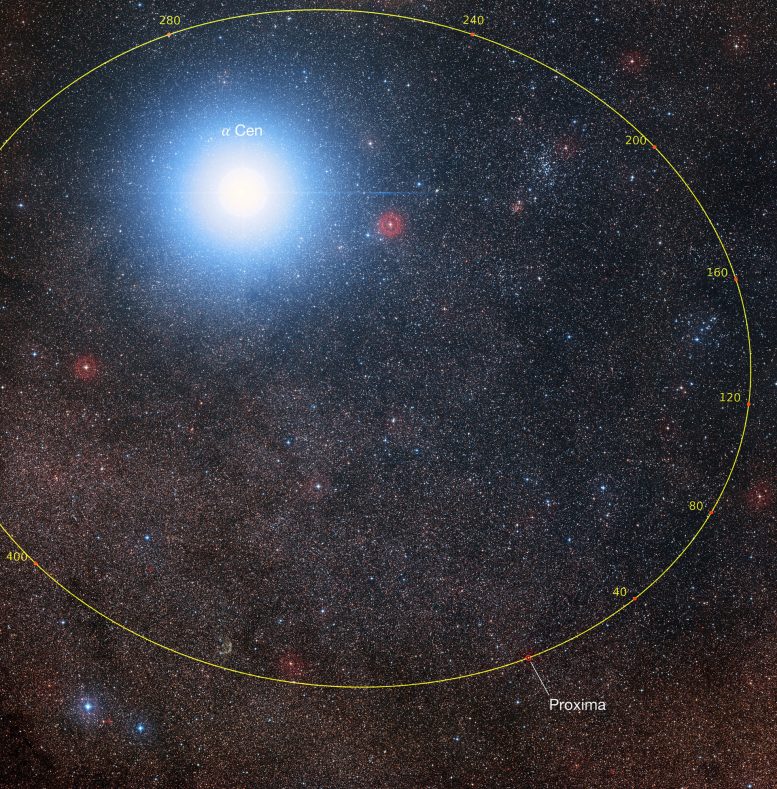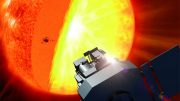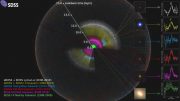
Orbital plot of Proxima Centauri showing its position with respect to Alpha Centauri over the coming millenia (graduations are in thousands of years). The large number of background stars is due to the fact that Proxima Cen is located very close to the plane of the Milky Way. Credit: P. Kervella (CNRS/U. of Chile/Observatoire de Paris/LESIA), ESO/Digitized Sky Survey 2, D. De Martin/M. Zamani
Using ESO’s planet-hunting HARPS instrument, astronomers have the strongest evidence to date that Proxima Centauri orbits Alpha Centauri A and B.
Interest in our neighboring Alpha Centauri star system has been particularly high since the recent discovery of an Earth-mass planet, known as Proxima b, orbiting the system’s third star — and the closest star to the Sun — Proxima Centauri. While the system’s larger stellar pair, Alpha Centauri A and B, appear to have a proper motion on the sky that is very similar to that of the smaller, fainter Proxima Centauri, it has not been possible to demonstrate that the three stars do actually form a single, gravitationally bound, triple system.
Now three astronomers, Pierre Kervella, Frédéric Thévenin and Christophe Lovis, have concluded that the three stars do indeed form a bound system. In the century since it was discovered, Proxima Centauri’s faintness has made it extremely difficult to reliably measure its radial velocity — the speed at which it moves towards and away from Earth. But now ESO’s planet-hunting HARPS instrument has provided an extremely precise measurement of Proxima Centauri’s radial velocity, and even greater accuracy has been achieved by accounting for other subtle effects.
As a result, the astronomers have been able to deduce very similar values for the radial velocities of the Alpha Centauri pair and Proxima Centauri, lending credence to the idea that they form a bound system. Taking account of these new measurements, calculations of the orbits of the three stars indicate that the relative velocity between Proxima Centauri and the Alpha Centauri pair is well below the threshold above which the three stars would not be bound together by gravity.
This result has significant implications for our understanding of the Alpha Centauri system and the formation of planets there. It strongly suggests that Proxima Centauri and the Alpha Centauri pair are the same age (about 6 billion years), and that in turn provides a good estimate of the age of the orbiting planet, Proxima b.
The astronomers speculate that the planet may have formed around Proxima Centauri on a more extended orbit and then been brought to its current position, very close to its parent star, as a result of the close passage of Proxima Centauri to its cousins in the Alpha Centauri pair. Alternatively, the planet may have formed around the Alpha Centauri pair, and was later captured by the gravity of Proxima Centauri. If one of these hypotheses is correct, it is possible that the planet was once an icy world that underwent a meltdown and now may have liquid water on its surface.
Reference: “Proxima’s orbit around α Centauri” by P. Kervella, F. Thévenin and C. Lovis, 30 January 2017, Astronomy & Astrophysics.
DOI: 10.1051/0004-6361/201629930









Well, we need to get someone out there to check things out!
Please let me know if you’re looking for a writer for your blog. You have some really great articles and I think I would be a good asset. If you ever want to take some of the load off, I’d absolutely love to write some material for your blog in exchange for a link back to mine. Please send me an email if interested. Cheers!
wonderful post, very informative. I wonder why the other experts of this sector don’t notice this. You must continue your writing. I am sure, you have a great readers’ base already!